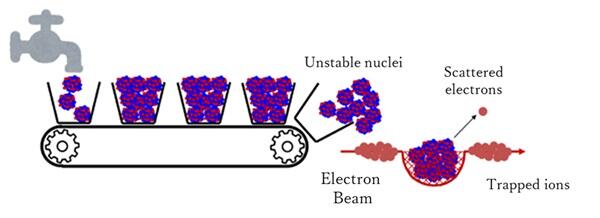A research group led by Director Tetsuya Ohnishi of the Instrumentation Development Group at the RIKEN Nishina Center for Accelerator-Based Science, and Associate Professor Kyo Tsukada of the Institute for Chemical Research (ICR) at Kyoto University, in collaboration with Rikkyo University and Tohoku University, announced that they have successfully performed high-energy electron scattering experiments on unstable atomic nuclei (unstable nuclei). The research group developed a technique to convert almost all unstable nuclei into pulsed beams and established stationary targets comprised of unstable nuclei by employing the Self-Confining RI Ion Target (SCRIT) method. This achievement is expected to pioneer research in the field of electron scattering on unstable nuclei, contributing to the development of a new atomic nuclei model. The results were published in the 30 August 2023 issue of the international journal Physical Review Letters.

Provided by RIKEN
Unstable nuclei have different characteristics from naturally occurring stable atomic nuclei (stable nuclei). They tend to decay into the stable nuclei over time due to an excess of either protons or neutrons. In theory, there are believed to be approximately 7,000 different types of unstable nuclei, but in reality, only approximately 3,000 types have been confirmed to exist. Advances in accelerator technology have made it possible to produce various unstable nuclei. These unstable nuclei are thought to be able to lead to a better understanding of the process of elemental synthesis in the universe.
In stable nuclei, the wave function (which represents the quantum state) can be determined by measuring the size and shape of the nucleus (proton distribution) through high-energy electron scattering. However, details about the structure of unstable nuclei remain unknown because stationary targets cannot be created for these nuclei.
In 2008, the research group developed the SCRIT method, which involves the creation of unstable nuclei by irradiating stable nuclei with an electron beam. Subsequently, a stationary target is crafted by trapping the unstable nuclei in the electron beam. Construction of the SCRIT electron scattering facility began in 2009 at the RIKEN Nishina Center for Accelerator-Based Science, and beam irradiation commenced in 2013. The research group established a system that facilitates electron scattering experiments on targets comprised of generated atomic nuclei, directly contributing to the development of the measurement device (online-produced radioactive target). In 2017, they successfully conducted electron scattering experiments using the SCRIT method, with a small amount (approximately 108) of stable nuclei.
In this study, they conducted an electron scattering experiment on a stationary target of the unstable nuclei cesium-137 (with 55 protons and 82 neutrons). The SCRIT electron scattering facility consists of an electron accelerator (150 MeV microtron RTM), an electron storage ring (SR2), and an unstable nuclei production separator (ERIS). The SCRIT device is installed within the linear section of SR2.
In this experiment, approximately 30 g of uranium (92U) was heated to approximately 2000 °C, while simultaneously being irradiated with an electron beam of approximately 20 W. The resulting fragments, characterized as unstable nuclei, were extracted as 137Cs ion beams using ERIS and subsequently accumulated in the cooler buncher (FRAC). This beam was converted into a pulsed beam, which was guided to the SCRIT device, where it was trapped three-dimensionally on the electron beam axis and became a floating target. Electrons impacted and scattered by the floating target were detected by the analyzing magnet (WiSES) and drift chamber detectors installed both in front of and behind the magnet to detect the direction of scattering, energy, and momentum. This facility is said to be a giant electron microscope that samples trace amounts of unstable nuclei.
They developed a new technology that allows for nearly 100% conversion into a pulse beam by synchronizing ERIS and FRAC and have implemented this advancement into their device. It is now possible to supply 137Cs pulsed beams with a uniform energy of approximately 4 x 107. With the conventional technology, the conversion efficiency was approximately 10%.
They measured elastic scattering events, wherein no energy is lost and only momentum is changed during the collision process. By reconstructing the orbits of the scattered electrons, the scattering point was identified, and the scattering angle and energy were obtained. To eliminate the influence of residual gas in the vacuum, they also measured the case of residual gas only and eliminated the influence of residual gas while obtaining the angular distribution of the elastic scattering event of 137Cs only. The measurement took three days.
The results show that each event from 137Cs ions and from residual gas is clearly different, confirming the first successful electron scattering of unstable nuclei.
Ohnishi said, "The construction of the facility began in 2009, but considering that it took nearly 20 years to realize the technique itself, this research is quite profound. Moving forward, our goal is to conduct electron scattering experiments on the unstable nuclei 132Sn (with 50 protons and 82 neutrons). To achieve this, we are planning to enhance the accelerator's power to approximately a hundred times its current capacity. Upgrades to the power source and related equipment are in the works, and since the project has already started, I expect to be able to conduct the experiment within a few years."
Journal Information
Publication: Physical Review Letters
Title: First Observation of Electron Scattering from Online-Produced Radioactive Target
DOI: 10.1103/PhysRevLett.131.092502
This article has been translated by JST with permission from The Science News Ltd. (https://sci-news.co.jp/). Unauthorized reproduction of the article and photographs is prohibited.




